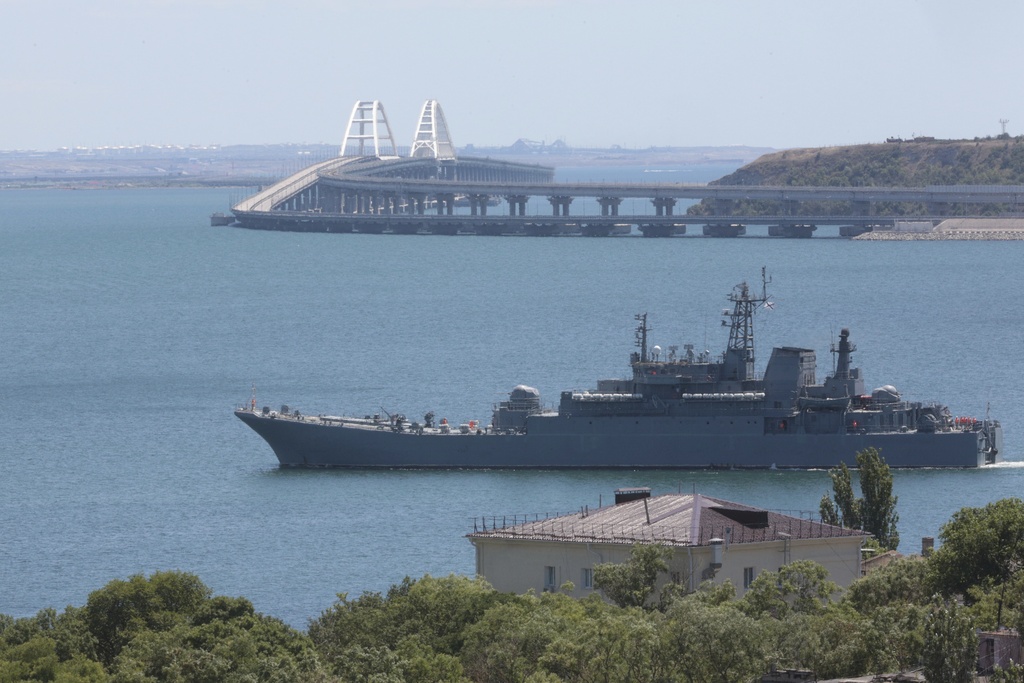
This article was originally published on NY Sun - Foreign. You can read the original article HERE
Russia withdrew its last warship from Crimea this week. It left with a whimper, in contrast to the booms of Russia’s previous defeats in the region: to a Franco-British alliance in the Crimean War in 1855 and to a Nazi-led alliance in World War II in 1942. With no modern rendering of “The Charge of the Light Brigade,” Ukraine pulled off its victory in the Battle of the Black Sea with robot drones and cruise missiles.
“Remember this day,” the Ukrainian Navy spokesman, Dmytro Pletenchuk, posted on Facebook. “The last patrol ship of the Russian Black Sea Fleet is leaving our Crimea right now.” In the larger picture of the Russia-Ukraine war, the land war looks like a stalemate. The sea war looks like a Ukrainian victory.
In two-and-a-half years of unconventional warfare, Ukraine, a nation without warships, has sunk or damaged one third of the 74 warships of Russia’s Black Sea Fleet. Surviving vessels have all retreated to Russia’s mainland port of the Novorossiysk or to the Sea of Azov.
Enforcing the 1936 Montreux Convention, Turkey, controller of the Bosphorus, refuses to allow warships in or out of the Black Sea. This freeze contributes to the collapse of Russian naval power in the Black Sea. This power vacuum provokes changes day by day.

Next Wednesday, for the first time since 2022, UkrFerry plans to resume passenger and cargo service between Odessa region and Batumi, Georgia. Once a week, this private ferry operator will offer weekly service across the Black Sea by the 623-foot long, German-built Kaunas.
Two years ago, Russian warships were blockading Ukraine’s Odessa region ports. Today, volumes of Ukrainian grain exports from Odessa are nearing pre-war levels. In the first half of this year, Odessa ports handled 53 million tons of cargo, compared with 31 million tons during the same period last year.
Showing there is a new sheriff in town, Ukrainian authorities last week impounded a grain ship, the USKO MFU, and arrested its captain on charges of trafficking grain from Russian-occupied areas through Crimea’s Sevastopol. On July 1, Bulgaria, Romania, and Turkey — all NATO nations — started joint demining operations in the area used by cargo ships going to Odessa.
Two years ago, Odessa residents spent the summer dreading Russian amphibious landings on their beaches. Since then, Ukraine sank or damaged all of Russia’s landing craft.
This summer, Russians arrive in Crimea on discount vacation packages to discover that beach sand has been dug up to fill sandbags for beachside bomb shelters. Last month, debris from an intercepted Ukrainian missile fell on one beach near Sevastopol, killing four and wounding dozens. After images circulated online of injured vacationers carried away on lounge chairs, a line of 1,000 cars formed at the Kerch bridge. Tourist bookings for August in Crimea are reportedly down by 30 percent.

Twice in the last two years, Ukraine has bombed this land link from the Crimean peninsula to mainland Russia. The two-track rail line is so shaky that the Russian Army has stopped using it to send trains loaded with heavy equipment — tanks and ammunition. At ports below the bridge, two roll-on roll-off ferries lie in ruins, victims of Ukrainian bombs.
To defend the 11-mile long bridge from kamikaze sea drones, Russia has placed booms, barriers, barges, and steel nets. With American-supplied tactical cruise missiles capable of reaching all of Crimea, many analysts believe that Ukraine simply is waiting for an auspicious date — perhaps Ukrainian Independence Day on August 24? — to finish off the $3.7 billion bridge, a pet project of President Putin.
Air raids and power blackouts are almost daily occurrences on Crimea. For example, on July 1, Ukrainian drones hit a thermal power station in Balaklava. In the 19th century, this Sevastopol district won international fame for lending its name to a woolen hat popular among British soldiers during the Crimean War. Yesterday, with power outages increasingly frequent, Mr. Putin took to national television to blame outages on crypto currency miners.

With Russia’s sea power largely neutralized, much of Ukraine’s bombing now is aimed at taking out radar, air fields, and surface-to-air missile sites. Since May, Ukraine has hit 15 major air defense sites on Crimea, the nation’s Center for Strategic Communications reported last month. The goal is to neutralize Crimea, a region that served for a decade as the Kremlin’s “unsinkable aircraft carrier.”
This destruction on Crimea and elsewhere has prompted Russia to move dozens of air defense systems to frontline areas near Ukraine from eastern Russia. A Japanese X account, AS-22, concludes from studying satellite imagery that since the war started, Russia has moved from 11 bases in Eastern Russia 105 missile transporter erector launchers for S-300 and S-400 surface-to-air systems. Most of the launchers on Russia-controlled islands north of Japan have been moved.
Ukraine’s destruction of these systems is seen as advance work for the entry in coming weeks of American-made F-16 fighter jets. Several European countries are donating a total of 80 F-16s to Ukraine as part of an upgrade program for NATO nations to buy F-35 multirole combat jets. With Ukrainian pilots, the F-16s will challenge Russia’s “full dominance” of the skies over the Black Sea, the Ukrainian vice-admiral Oleksiy Neizhpapa told Reuters two weeks ago.
“F-16s with the right armaments will be able to push away Russian warplanes,” he said at Odessa. “The northwestern part of the Black Sea, particularly the corridor for civilian ships, will be almost 100 percent secure.”
During the 10 years since Russia annexed Crimea from Ukraine, Russian propaganda has treated the peninsula as Russia’s “holy land.” The land grab is seen as a keystone achievement of Mr. Putin’s 25 years in power. In that light, analysts study how the Russian president reacts to Ukraine crossing one of his big “red lines.”
“A cornered and beaten Vladimir Putin could potentially resort to the most extreme measures, including the use of nuclear weapons,” Atlantic Council editor Peter Dickson wrote Tuesday from Kyiv in an essay titled: “Russia’s retreat from Crimea makes a mockery of the West’s escalation fears.” Mr. Dickson notes that Mr. Putin, to the contrary, “has responded to the humiliating defeat of the Black Sea Fleet by quietly ordering his remaining warships to retreat.”
This article was originally published by NY Sun - Foreign. We only curate news from sources that align with the core values of our intended conservative audience. If you like the news you read here we encourage you to utilize the original sources for even more great news and opinions you can trust!









Comments